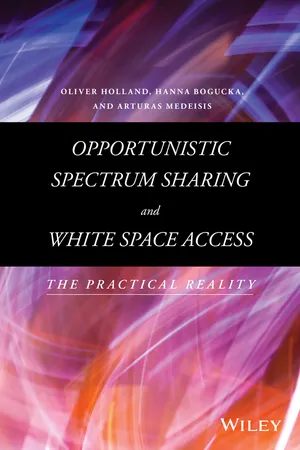
Opportunistic Spectrum Sharing and White Space Access
The Practical Reality
- English
- ePUB (mobile friendly)
- Available on iOS & Android
Opportunistic Spectrum Sharing and White Space Access
The Practical Reality
About this book
Details the paradigms of opportunistic spectrum sharing and white space access as effective means to satisfy increasing demand for high-speed wireless communication and for novel wireless communication applications This book addresses opportunistic spectrum sharing and white space access, being particularly mindful of practical considerations and solutions. In Part I, spectrum sharing implementation issues are considered in terms of hardware platforms and software architectures for realization of flexible and spectrally agile transceivers. Part II addresses practical mechanisms supporting spectrum sharing, including spectrum sensing for opportunistic spectrum access, machine learning and decision making capabilities, aggregation of spectrum opportunities, and spectrally-agile radio waveforms. Part III presents the ongoing work on policy and regulation for efficient and reliable spectrum sharing, including major recent steps forward in TV White Space (TVWS) regulation and associated geolocation database approaches, policy management aspects, and novel licensing schemes supporting spectrum sharing. In Part IV, business and economic aspects of spectrum sharing are considered, including spectrum value modeling, discussion of issues around disruptive innovation that are pertinent to opportunistic spectrum sharing and white space access, and business benefits assessment of the novel spectrum sharing regulatory proposal Licensed Shared Access. Part V discusses deployments of opportunistic spectrum sharing and white space access solutions in practice, including work on TVWS system implementations, standardization activities, and development and testing of systems according to the standards.
- Discusses aspects of pioneering standards such as the IEEE 802.22 "Wi-Far" standard, the IEEE 802.11af "White-Fi" standard, the IEEE Dynamic Spectrum Access Networks Standards Committee standards, and the ETSI Reconfiguration Radio Systems standards
- Investigates regulatory and regulatory-linked solutions assisting opportunistic spectrum sharing and white space access, including geo-location database approaches and licensing enhancements
- Covers the pricing and value of spectrum, the economic effects and potentials of such technologies, and provides detailed business assessments of some particularly innovative regulatory proposals
The flexible and efficient use of radio frequencies is necessary to cater for the increasing data traffic demand worldwide. This book addresses this necessity through its extensive coverage of opportunistic spectrum sharing and white space access solutions. Opportunistic Spectrum Sharing and White Space Access: The Practical Reality is a great resource for telecommunication engineers, researchers, and students.
Frequently asked questions
- Essential is ideal for learners and professionals who enjoy exploring a wide range of subjects. Access the Essential Library with 800,000+ trusted titles and best-sellers across business, personal growth, and the humanities. Includes unlimited reading time and Standard Read Aloud voice.
- Complete: Perfect for advanced learners and researchers needing full, unrestricted access. Unlock 1.4M+ books across hundreds of subjects, including academic and specialized titles. The Complete Plan also includes advanced features like Premium Read Aloud and Research Assistant.
Please note we cannot support devices running on iOS 13 and Android 7 or earlier. Learn more about using the app.
Information
PART I
FLEXIBLE RADIO HARDWARE AND SOFTWARE PLATFORMS SUPPORTING SPECTRUM SHARING
1
THE UNIVERSAL SOFTWARE RADIO PERIPHERAL (USRP) FAMILY OF LOW-COST SDRs
1.1 OVERVIEW
1.1.1 Software Defined Radio and Opportunistic Spectrum Access
1.1.2 Principles of SDR

Table of contents
- COVER
- TITLE PAGE
- TABLE OF CONTENTS
- LIST OF CONTRIBUTORS
- INTRODUCTION
- ACRONYMS
- PART I: FLEXIBLE RADIO HARDWARE AND SOFTWARE PLATFORMS SUPPORTING SPECTRUM SHARING
- PART II: PRACTICAL MECHANISMS SUPPORTING SPECTRUM SHARING
- PART III: REGULATORY SOLUTIONS FOR SPECTRUM SHARING
- PART IV: SPECTRUM SHARING BUSINESS SCENARIOS AND ECONOMIC CONSIDERATIONS
- PART V: SPECTRUM SHARING DEPLOYMENT SCENARIOS IN PRACTICE
- CONCLUSIONS AND FUTURE WORK
- INDEX
- END USER LICENSE AGREEMENT